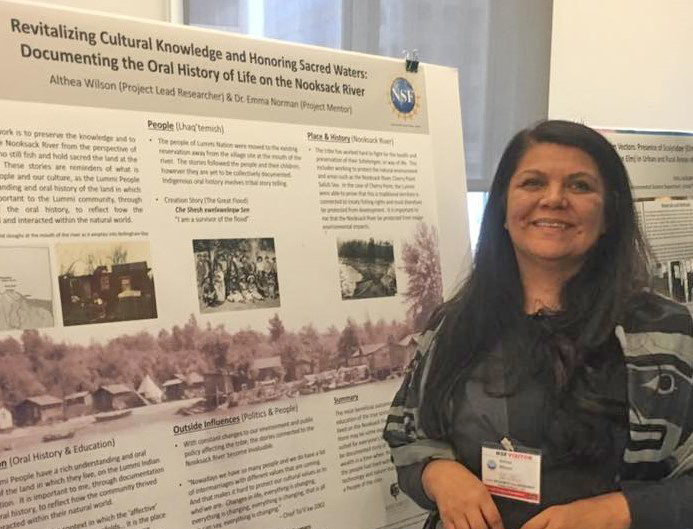Northwest Indian College student Althea Wilson found her path to science by investigating the cultural significance of the Nooksack River. Her capstone project can be viewed here.
By Paul Boyer
The Nooksack River is a modest 75-mile waterway in the northwest corner of Washington State, flowing westward from its headwaters near Mount Baker to Bellingham Bay on the Lummi Reservation. Seen on a map, it is easily overlooked. For Native peoples of the region, however, the ebb and flow of the water once shaped daily life. Knowing what the river was doing could even be a matter of life and death.
Chief Tsilixw, hereditary chief of the Lummi Nation, recalled that, as a boy, his father would sometimes tell him to sleep with one foot touching the floor. If he woke in the night with his toes in water, it meant floodwaters were rising through their home’s floorboards and it was time to leave. In preparation, the family kept a boat tied to their front door.
For Althea Wilson, who recently graduated from Northwest Indian College with a B.S. degree in Native Environment Science, these memories are more than stories. They reflect a deep connection between the Lummi people and the land. This affiliation with the river—and the larger environment—sustained the community and shaped their collective identity.
To both document and explore the meaning of this relationship, Wilson interviewed long-time residents about their memories of life along the river. The project resulted in a 40-minute video, Revitalizing Cultural Knowledge and Honoring Sacred Waters Through the Telling of Oral History of Life on the Nooksack River, which served as her capstone project.
In the video, tribal members recall the drama of river flooding (including Chief Tsilixw’s story of flooded homes), the location of now-abandoned homesites, and days when, it seemed, “everyone was on the river,” especially during fishing season.

In a 2018 talk, also available for viewing, Wilson provides a thoughtful summary of her own educational journey. She first enrolled at Northwest Indian College in the early 1980s, but left because she was “afraid of math,” reflecting the discouragement she experienced in high school; struggling academically, she was told that she was too stupid to learn. Determined to overcome this stigma, she returned to college as an adult. She made a deal with herself: she would take and pass a statistics class.
When she cleared that hurdle, she found herself on a path to a degree. Supportive Northwest Indian College faculty, including Dr. Emma Norman, proposed that she consider the newly created four-year Native Environmental Science program. “I thought that was the craziest idea ever,” Wilson said. “Obviously, I didn’t know how to do math, and I didn’t like science.” But she eventually came to see herself as a capable student, and credits chemistry instructor John Rombold for making her see that she was, in fact, a really smart person. “He had to teach me that I could learn.”
She realized that her lack of confidence was not her failing, but the result of the nation’s longstanding neglect of Native peoples, as well as Western science’s reflexive denigration of Native knowledge. She learned that “the problem was not my ability to learn or his ability to teach, but everything that got in between.”
Learning about this history made her angry, she said. “I would call and say, ‘I’m not coming to class. I’m really upset with the policymakers and I don’t like the history.’” But this anger was also motivating. As a challenge to Western science, her capstone project was purposefully shaped by a respect for traditional local knowledge. Her goal was to develop a project that would honor culture and strengthen the community.
Over a year in the making, her video was part of an interdisciplinary program that incorporated a horizon-expanding exploration of federal policy and Native knowledge, as well as an opportunity to help develop a research project grounded in Native research methodologies. Filled with enthusiasm for her subject, she called it “the best project ever.” All this, combined with strong support from faculty and mentors, not only allowed Wilson to master content, but to also, and more importantly, see herself as a smart person, as a scientist, and as a person who could use science to serve the Lummi Nation.
Native Environmental Science Department Chair Emma Norman reports that Wilson, who graduated in 2018, now serves as the program’s curriculum coordinator. Additionally, “she is continuing the work of our Nooksack River Project and helping to grow it to other sites.”
Paul Boyer is editor of Native Science Report.
